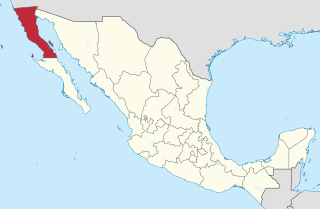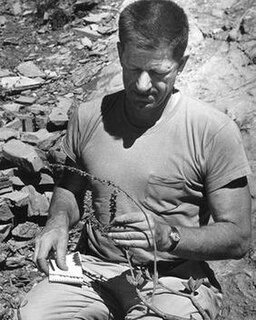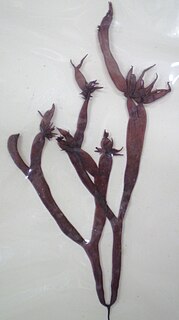
The Baja California peninsula is a peninsula in Northwestern Mexico. It separates the Pacific Ocean from the Gulf of California. The peninsula extends 1,247 km from Mexicali, Baja California in the north to Cabo San Lucas, Baja California Sur in the south. It ranges from 40 km at its narrowest to 320 km at its widest point and has approximately 3,000 km of coastline and approximately 65 islands. The total area of the Baja California Peninsula is 143,390 km2 (55,360 sq mi), roughly the same area as the country of Nepal.

Baja California, officially the Free and Sovereign State of Baja California is a state in Mexico. It is the northernmost and westernmost of the 32 federal entities of Mexico. Before becoming a state in 1952, the area was known as the North Territory of Baja California. It has an area of 70,113 km2 (27,071 sq mi) and comprises the northern half of the Baja California Peninsula, north of the 28th parallel, plus oceanic Guadalupe Island. The mainland portion of the state is bordered on the west by the Pacific Ocean; on the east by Sonora, the U.S. state of Arizona, and the Gulf of California; on the north by the U.S. state of California; and on the south by Baja California Sur.

Baja California Sur, officially the Free and Sovereign State of Baja California Sur, is the second-smallest Mexican state by population and the 31st admitted state of the 32 states which make up the 31 States of Mexico. It is also the ninth-largest Mexican state in terms of area.

John Xantus de Vesey a.k.a. de Csíktaplócza was a Hungarian exile and zoologist. Xantus was born Xántus János, in Csokonya, Somogy, Hungary.

The Californias, occasionally known as The Three Californias or Two Californias, are a region of North America spanning the United States and Mexico, consisting of the U.S. state of California and the Mexican states of Baja California and Baja California Sur. Historically, the term Californias was used to define the vast northwestern region of Spanish America, as the Province of the Californias, and later as a collective term for Alta California and the Baja California Peninsula.

Chaenactis is a genus of plants in the daisy family which are known generally as pincushions or dustymaidens.

Chaenactis fremontii, with the common names Frémont's pincushion and desert pincushion, is a species of annual wildflower in the daisy family. Both the latter common name, and the specific epithet are chosen in honor of John C. Frémont.

Chaenactis artemisiifolia, with the common name white pincushion, is a species of flowering plant in the daisy family. It is native to the coastal Peninsular Ranges of Southern California and Baja California, in the chaparral and woodlands.

Chaenactis carphoclinia is a species of flowering plant in the daisy family known by the common name pebble pincushion. It is native to the southwestern United States and northwestern Mexico, where it grows in rocky and gravelly habitat, such as the California deserts. The species is found in southern California, Nevada, Utah, Arizona, southwestern New Mexico, Baja California, Sonora.

Chaenactis douglasii is a North American species of flowering plant in the daisy family known by the common name Douglas' dustymaiden.

Chaenactis glabriuscula, with the common name yellow pincushion, is a species of flowering plant in the daisy family. It is native to California and Baja California.
Chaenactis parishii is a species of flowering plant in the daisy family known by the common name Parish's chaenactis.

Chaenactis stevioides, with the common names Esteve's pincushion and desert pincushion, is a species of flowering plant in the daisy family.
Alvordia is a genus of flowering plants in the family Asteraceae. It includes 4 species of shrubs which occur in the states of Baja California and Sonora, Mexico. The genus is characterized by having a secondary clustering of heads into compound units, so that what appears to be a single head is actually a group of heads packed together. The genus is classified as a member of subtribe Helianthinae, the same subtribe that contains the common sunflower (Helianthus). Based on the reported chromosome counts, Alvordia includes both diploid and polyploid species, but the relationships among these have not yet been studied in detail. No chromosome count has yet been reported for the species A. congesta from Sonora, which was a later transfer to the genus.
Amauria is a genus of flowering plants in the family Asteraceae described as a genus in 1844.

The Inaja Band of Diegueño Mission Indians of the Inaja and Cosmit Reservation is a federally recognized tribe of Kumeyaay Indians, who are sometimes known as Mission Indians.

Reid Venable Moran was an American botanist and the curator of botany at the San Diego Natural History Museum from 1957 to 1982.

Gloiopeltis furcata, commonly known as glueweed, jelly moss and fukuro-funori (Japan), is a marine alga that is widely distributed in the North Pacific Ocean, along the shorelines of China, Taiwan, Korea, Japan, and the Pacific shores of Russia; and from the Aleutian Islands south to Baja California. G. furcata has long been utilized as a food source in Asia, where it is also used as a sizing material in silk and other textiles. G. furcata is also a raw material for textile binders. Studies show that extracts of G. furcata inhibit the growth of several human cancer cell lines, and can significantly lower blood glucose levels.
Chaenactis lacera is a Mexican species of flowering plants in the aster family. It grows on the Baja California Peninsula in northwestern Mexico, the States of Baja California and Baja California Sur.

Ira Loren Wiggins was an American botanist, Curator of the Dudley Herbarium, and Director of the Natural History Museum (1940–1962) at Stanford University. He was a Stanford faculty member from 1929 until his retirement in 1964. He was the first recipient of the Fellow's Medal of the California Academy of Sciences. His Flora of Baja California is a standard work on the botany of the Baja peninsula and on the many islands of the Gulf of California.














